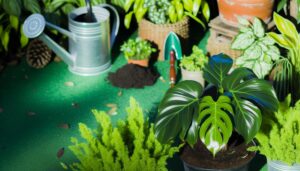Caring for an Monstera Siltepecana: A Complete Guide!
To care for your Monstera Siltepecana, place it in bright, indirect light and keep it away from direct sunlight. Water when the top 2-3 inches of soil dry out, roughly every 7-10 days during the growing season, and reduce in dormancy.
Maintain a temperature between 60-80°F and humidity levels at 60-80%. Use a well-draining soil mix rich in organic matter.
Regularly check for pests and clean leaves with a damp cloth. Repot when necessary, ensuring proper drainage.
For more detailed care tips and advanced techniques, there’s much more to explore.
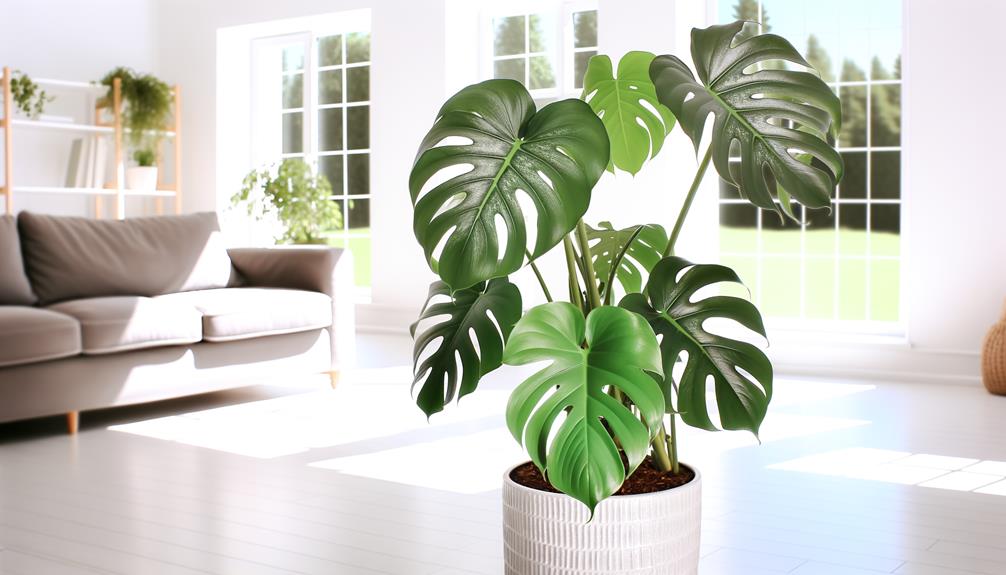
Key Takeaways
- Place Monstera Siltepecana in bright, indirect light, avoiding direct sunlight to prevent leaf scorching.
- Water when the top 2-3 inches of soil are dry, typically every 7-10 days during the growing season.
- Maintain a temperature range of 60°F to 80°F, avoiding exposure to drafts and direct heat sources.
- Keep humidity levels between 60% to 80%, using a hygrometer for accuracy and a humidifier if needed.
- Use a well-draining soil mix with components like perlite, coconut coir, and compost for optimal growth.
Comprehensive Care Guide for Monstera Siltepecana: Tips for Thriving Growth
| Care Aspect | Ideal Conditions | Notes |
|---|---|---|
| Light | Bright, indirect light | Avoid direct sunlight to prevent leaf burn. |
| Watering | Keep soil slightly moist, water when top inch is dry | Overwatering can cause root rot. |
| Humidity | 60-80% humidity preferred | Use a humidifier or pebble tray if air is too dry. |
| Temperature | 65-85°F (18-29°C) | Avoid cold drafts and sudden temperature changes. |
| Soil | Well-draining potting mix with peat or perlite | Ensure good drainage to prevent soggy roots. |
| Fertilizing | Use balanced fertilizer every 4-6 weeks during growing season | Avoid over-fertilizing to prevent salt build-up. |
| Repotting | Repot every 1-2 years or when roots outgrow the pot | Choose a pot one size larger each time. |
| Pruning | Prune to control size and promote bushier growth | Cut below a leaf node for best results. |
| Pests | Watch for spider mites, aphids, and mealybugs | Treat with insecticidal soap or neem oil if needed. |
| Propagation | Propagate through stem cuttings in water or soil | Ensure cuttings have at least one node. |
Light Requirements
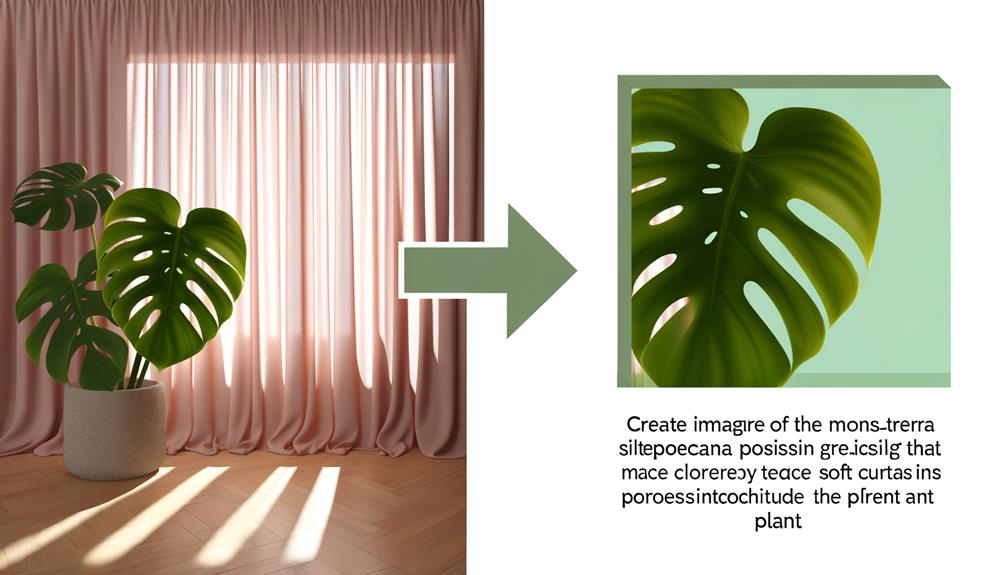
To maximize growth, you should place your Monstera Siltepecana in bright, indirect light. This plant thrives best when it receives around 70-85% filtered sunlight. Direct sunlight can scorch its leaves, causing brown spots. Place it near an east or north-facing window, where it can get gentle morning light.
If you’re using artificial lighting, choose full-spectrum LED grow lights. Position the lights about 12-18 inches above the plant, ensuring they’re on for approximately 12-14 hours daily. Monitor the plant’s leaves; yellowing might indicate too much light, while stretching or small leaves suggest insufficient light.
Adjust the light source accordingly to maintain ideal growth conditions. Proper lighting is essential for the Monstera Siltepecana’s health and vigor.
Watering Schedule
Maintaining a consistent watering schedule is crucial for the health of your Monstera Siltepecana. You should water it when the top 2-3 inches of soil feel dry to the touch. Use a moisture meter for precision if you’re uncertain.
Overwatering can lead to root rot, so make sure the pot has adequate drainage holes. During the growing season (spring and summer), you may need to water more frequently, approximately every 7-10 days. In the dormant period (fall and winter), reduce watering to every 2-3 weeks.
Always use room-temperature water to avoid shocking the roots. If the leaves start to yellow, it could be a sign of either too much or too little watering, so adjust accordingly.
Ideal Temperature

Your Monstera Siltepecana thrives best in temperatures ranging from 60°F to 80°F, ensuring its growth and overall health. Maintaining this temperature range is essential for peak photosynthesis and metabolic functions.
Avoid exposing the plant to temperatures below 50°F as this can cause stress, leading to leaf damage and stunted growth. Similarly, temperatures above 85°F can induce heat stress, resulting in leaf curling and browning.
Place your Monstera in a location that experiences consistent temperatures, away from drafts or direct heat sources like radiators. During winter months, monitor indoor temperatures closely, as sudden drops can be detrimental.
Use a reliable thermometer to track the ambient temperature, ensuring it remains within the ideal range for your plant’s well-being.
Humidity Needs
Monstera Siltepecana requires a humidity level of 60% to 80% to flourish, closely mimicking its native tropical environment. You’ll need to maintain consistent humidity, especially during drier months.
Use a hygrometer to monitor levels accurately. If your home’s air is too dry, increase humidity by using a humidifier or placing a pebble tray filled with water beneath the plant’s pot. Misting the leaves can provide temporary relief but isn’t a long-term solution.
Positioning the plant in a bathroom or kitchen, where humidity levels are naturally higher, can also be beneficial. Avoid placing it near heating vents or drafty windows, as fluctuations in humidity can stress the plant.
Keeping consistent humidity will promote lush, healthy growth.
Soil Preferences
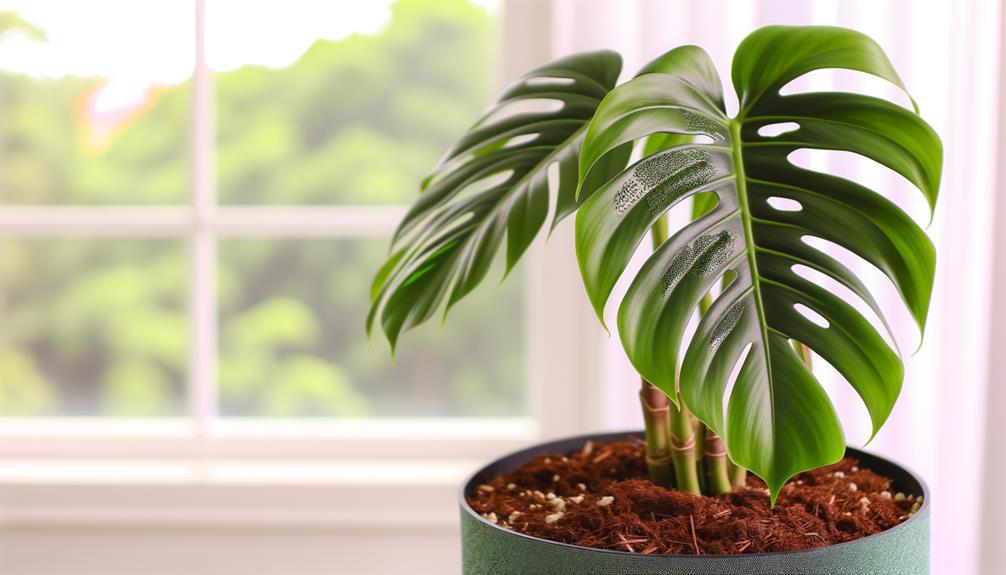
To complement its humidity needs, verify the Monstera Siltepecana is planted in a well-draining soil mix rich in organic matter. This guarantees the roots remain aerated and reduces the risk of root rot. An ideal mix includes components that retain moisture without becoming waterlogged.
Consider including:
- Perlite: Enhances drainage and aeration.
- Coconut coir: Retains moisture while allowing air flow.
- Pine bark: Adds organic matter and aids in drainage.
- Compost: Provides essential nutrients and sustains beneficial microbes.
- Sphagnum peat moss: Balances moisture retention with aeration.
These ingredients create an ideal environment, replicating the plant’s natural habitat.
Keep the soil slightly moist but not soggy, adjusting your watering schedule based on the plant’s needs.
Fertilizing Tips
When fertilizing your Monstera Siltepecana, choose a balanced, water-soluble fertilizer with an N-P-K ratio of 20-20-20. Feed the plant every four to six weeks during the growing season, usually from spring to early fall.
Make sure you dilute the fertilizer to half the recommended strength to prevent nutrient burn.
Choosing the Right Fertilizer
Selecting the ideal fertilizer for your Monstera Siltepecana involves understanding its nutrient requirements and growth patterns. This plant thrives with a balanced 20-20-20 NPK (Nitrogen, Phosphorus, Potassium) fertilizer, ensuring strong foliage and root development. You should also consider a liquid or water-soluble formula for ease of application.
To make the right choice, keep these factors in mind:
- Nutrient Balance: Guarantee the fertilizer provides equal parts nitrogen, phosphorus, and potassium.
- Application Method: Opt for liquid or water-soluble forms over granular types.
- Frequency: Choose a fertilizer that can be applied bi-weekly or monthly.
- Organic Options: Think about organic fertilizers for a more natural nutrient source.
- Micronutrients: Search for added micronutrients like iron and magnesium.
Optimal Feeding Schedule
Establishing a prime feeding schedule for your Monstera Siltepecana involves understanding its growth cycle and seasonal changes to secure maximum nutrient uptake.
During the growing season, typically from spring to early fall, feed your plant every two weeks with a balanced, water-soluble fertilizer diluted to half strength. This guarantees a steady supply of essential nutrients.
In the dormant winter months, reduce feeding to once a month or cease entirely, as the plant’s nutrient requirements decrease.
Always water the soil before applying fertilizer to prevent root burn.
Monitor your Monstera for signs of over-fertilization, such as yellowing leaves or salt buildup on the soil.
Adjust the schedule as needed to maintain peak health and growth.
Pruning Techniques
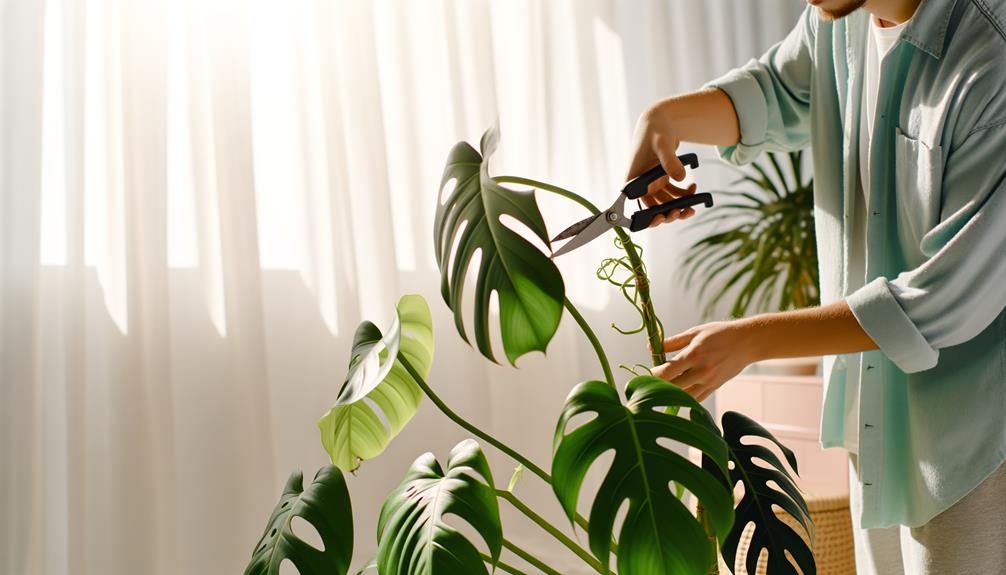
Pruning Monstera Siltepecana involves strategically trimming back overgrown or damaged vines to promote healthier growth and a more aesthetically pleasing appearance. Use sterilized pruning shears to make clean cuts just above a node, where new growth will emerge.
Regular pruning helps manage the plant’s size and prevents legginess. Focus on removing:
- Dead or yellowing leaves: To redirect energy to healthier parts.
- Damaged vines: To prevent disease spread.
- Overgrown sections: To maintain a balanced shape.
- Crowded areas: To enhance air circulation.
- Unwanted growth: To promote bushier development.
Always prune during the growing season, ideally in spring or early summer. This guarantees your Monstera Siltepecana recovers quickly and continues to thrive.
Common Pests
When caring for your Monstera Siltepecana, you’ll need to watch out for common pests like spider mites, mealybugs, and aphids. Identify these pests early by regularly inspecting the undersides of leaves and stems.
Use natural remedies like neem oil and insecticidal soap, and maintain proper humidity and cleanliness to prevent infestations.
Identifying Common Pests
Among the most common pests that can affect your Monstera Siltepecana are spider mites, mealybugs, and scale insects, each requiring specific identification and control measures.
Spider mites leave fine webbing and tiny yellow spots on the leaves.
Mealybugs appear as small, white cottony masses, often at leaf joints.
Scale insects manifest as small, brown, oval-shaped bumps that can be easily mistaken for part of the plant.
To identify these pests, you should:
- Inspect the undersides of leaves regularly.
- Look for abnormal leaf discoloration.
- Check for sticky residue (honeydew) on leaves.
- Notice any distorted or stunted growth.
- Use a magnifying glass for a closer inspection.
Natural Pest Remedies
Implementing natural pest remedies can effectively manage common pests like spider mites, mealybugs, and scale insects without resorting to harsh chemicals. Start by using neem oil, a powerful natural insecticide. Dilute it according to the package instructions and spray it on the leaves, ensuring thorough coverage.
You can also introduce beneficial insects like ladybugs or predatory mites to control pest populations biologically. Another effective method is using insecticidal soap; mix a mild concentration and apply it directly to the pests. For mealybugs, dab them with a cotton swab dipped in rubbing alcohol. This kills them on contact.
Consistently monitor your Monstera Siltepecana, reapplying treatments as necessary to keep these pests at bay.
Prevention and Maintenance
Consistent monitoring and proper care practices are essential in preventing common pests from infesting your Monstera Siltepecana. Regularly inspecting the plant and maintaining ideal growing conditions will help keep pests at bay. Ensure sufficient air circulation by not overcrowding your plant.
Avoid overwatering, as excess moisture can attract pests like fungus gnats. Use insecticidal soap or neem oil as a preventive measure against common pests such as spider mites, aphids, and mealybugs.
Here are key practices to implement:
- Inspect leaves and stems regularly for signs of pests.
- Maintain appropriate humidity levels to deter spider mites.
- Clean leaves with a damp cloth to remove dust and potential pest eggs.
- Quarantine new plants before introducing them.
- Use natural treatments proactively.
Disease Prevention

Preventing disease in your Monstera Siltepecana involves maintaining ideal humidity levels and promoting proper air circulation around the plant. Keep humidity between 60-80% to mimic its natural environment. Use a hygrometer to monitor this. Place a humidifier nearby if levels drop.
Enhance air circulation by placing a small fan close to the plant, which helps prevent fungal growth. Avoid overwatering; waterlogged soil invites root rot. Use a well-draining potting mix to facilitate this.
Regularly inspect leaves for signs of pests like spider mites or mealybugs. Treat infestations promptly with insecticidal soap. Sterilize pruning tools before use to prevent pathogen transfer.
Repotting Guide
When repotting your Monstera Siltepecana, choose a pot that’s one to two inches larger in diameter than the current one to allow for root growth.
Opt for a well-draining soil mix, ideally containing a blend of peat moss, perlite, and orchid bark.
Verify the new pot has drainage holes to prevent waterlogging and root rot.
Choosing Pot Size
Selecting the right pot size for your Monstera Siltepecana is vital, as it directly impacts root development and overall plant health. When choosing a pot, make sure it’s about 2 inches larger in diameter than the current one. This allows room for growth without overwhelming the roots. Avoid excessively large pots to prevent waterlogging and root rot.
Consider these key points:
- Drainage: Ensure the pot has sufficient drainage holes.
- Material: Use breathable materials like terracotta for better moisture control.
- Depth: The pot should be deep enough to support root expansion.
- Stability: A heavier pot provides stability for the climbing plant.
- Size Increment: Increase pot size gradually to avoid shock.
These considerations are essential for maintaining a healthy Monstera Siltepecana.
Soil Mix Selection
Guaranteeing your Monstera Siltepecana thrives necessitates a well-draining soil mix that mimics its natural tropical habitat. Start by combining equal parts of peat moss, perlite, and orchid bark. Peat moss retains necessary moisture, while perlite guarantees excellent aeration. Orchid bark adds essential organic matter and mimics the forest floor. Avoid heavy soils that retain too much water, as they can lead to root rot.
For added benefits, consider mixing in a small amount of charcoal to deter bacteria and fungi.
When repotting, gently remove the old soil from the roots, making sure they remain intact. Place the plant in its new pot, fill with the prepared mix, and water thoroughly. This soil mix will support robust growth and vibrant foliage.
Propagation Methods
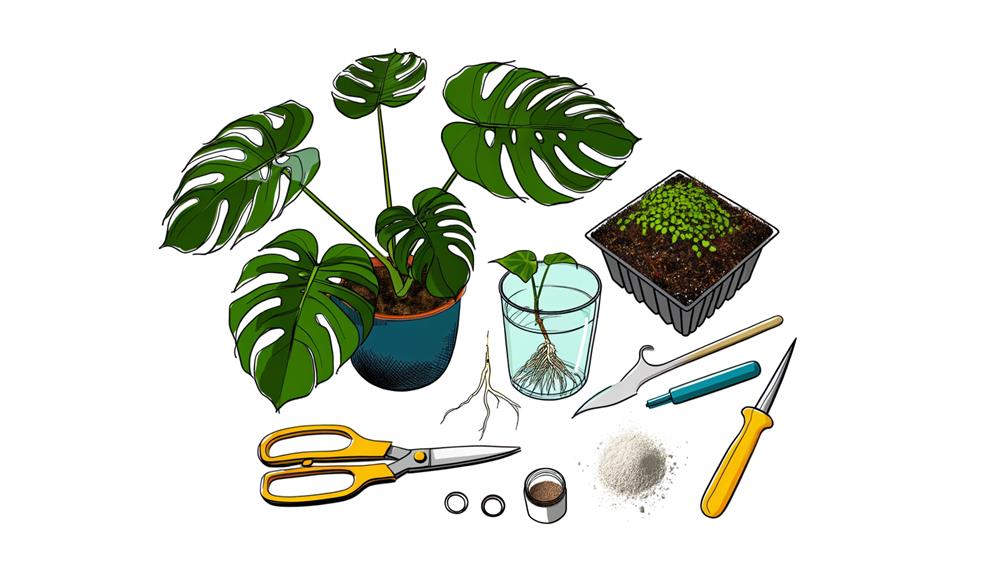
To propagate a Monstera Siltepecana, you can use the stem cutting method to ensure successful root development.
Start by selecting a healthy stem with at least one node and a leaf. Cut just below the node using sanitized pruning shears.
Place the cutting in water or moist sphagnum moss to promote root growth. Confirm the environment is warm and humid, as this accelerates rooting.
Following these steps guarantees successful propagation.
Conclusion
In caring for your Monstera siltepecana, you’ve become a maestro, orchestrating light, water, and soil into a symphony of growth. By mastering its needs—optimal light, precise watering, and perfect humidity—you breathe life into its emerald leaves.
You’re not just a gardener; you’re a guardian against pests and disease, a nurturer through repotting and propagation. With dedication, your Monstera will flourish, each leaf a proof to your meticulous care and unyielding passion.



